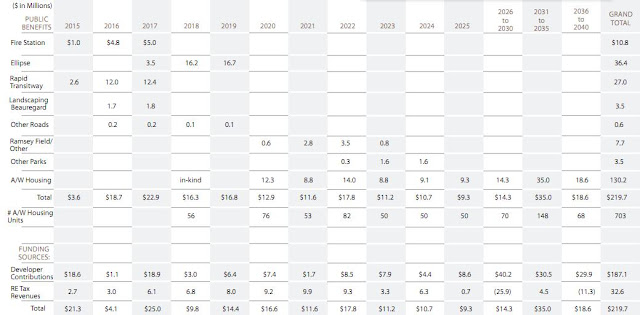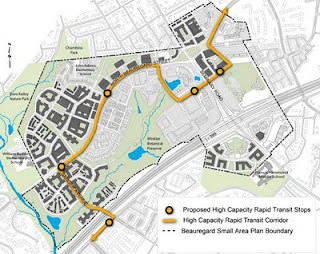Beauregard plan brings better buses, affordable housing
The city of Alexandria is in a period of transition. As older suburban strips come under increasing pressure to redevelop, the city is working hard on solutions to transportation issues and increasing the supply of affordable housing. The Beauregard area plan is a key example of these challenges and potential solutions.
“We’re growing as a city and as a region, so how do we manage that growth?” This was the focus of Alexandria Deputy Director of Planning and Zoning Jeff Farner as he presented the draft Beauregard Small Area Plan at a recent press conference.
Beauregard, which lies northwest of I-395 between the Landmark area and King St, is currently comprised of low density garden style apartments. But with the addition of Bus Rapid Transit, additional density, and the preservation of 703 units of affordable housing, the area is primed for change.
Alexandria is in a period of urbanization, a transformation from largely suburban apartment housing, strip mall shopping centers, and industrial brownfield areas to a series of walkable, mixed-use, transit oriented places. At the same time, the housing stock in much of Alexandria is aging and reaching the end of its useful life.
Now the city is working feverishly, using a rare opportunity when so many developments need to be replaced within a few decades to undo mistakes of the past 40 to 50 years. Simultaneously, the city is riding the Transit Oriented Development wave and filling in formerly industrial brownfield sites while trying to keep traffic impacts to a minimum.
Not everyone welcomes all these changes. Real estate values in walkable neighborhoods are on the rise, a sure sign that demand for such units outstrips supply. Unfortunately, that also means creating new walkable places will often drive housing prices out of the affordable range, even for those making 70 or 80% of Area Median Income (AMI).
But what can be done when a building reaches the end of its useful life? With today’s construction costs, even renovating or rebuilding an old building will drive rent prices out of reach for many existing residents.
Deputy City Manager Mark Jinks highlighted one example of this in the Beauregard corridor, where the Encore building saw rent increases of 90% after renovation. Jinks warned that without proper planning, this pattern will be repeated as developers update and replace their aging buildings and look to recoup costs.
With the Beauregard Small Area Plan, Alexandria may have partially solved that problem. Under the proposed plan, as the corridor rebuilds, the 5 developers involved will fund the majority of the creation of 703 dedicated affordable and workforce housing units. The development footprint currently contains over 5,500 total units of housing.
According to the plan, “approximately 44% of the existing units [in the plan area] are market rate affordable units, which constitutes more than 25% of the City’s total market affordable housing inventory.” Of the current 2515 units of market rate affordable housing, the plan as drafted would ensure that 28% of the existing affordable housing units are retained as dedicated affordable and workforce housing units. Depending on future market rates, additional housing may stay in the affordable range.
The units will be broken down into three levels of affordability, with those making a maximum of 55%, 65%, and 80% of AMI eligible to rent the various units. As is the standard, rents of affordable housing units will be set to a maximum 30% of the AMI tier.
For example from the following chart, 60% of AMI is currently about $58,050 for a three-person household, and rent for a two bedroom apartment is set to a maximum of $1,432 per month and a three bedroom comes in at no more than $1,655. The two bedroom rate is below 30% of their earnings, while the three bedroom comes in slightly above. Of course, those making less than 55% of of AMI are still eligible to rent the units as long as they are tenants in good standing. In some cases, housing vouchers could help lower earning tenants make rent.
Each affordable housing unit will cost the City somewhere in the ballpark of $47,000. Montgomery County recently posed as much as $90,000 per affordable housing unit in a similarly sized affordable housing push. Alexandria’s lower share per unit in this plan appears due to the developer picking up a substantial chunk of the cost in exchange for upzoning.
The Beauregard Small Area Plan covers 220 acres, more than three times the 70 acres of the North Potomac Yard Small Area Plan. The planning process was led by a developer-funded consultant working closely with the City and the community over a 2-year planning period.
The study area currently contains development totaling about 6 million square feet. Current zoning allows up to about 10 million square feet, but the plan calls for upzoning to allow 12-million square feet of development. This would include a minimum of 250,000 square feet of retail between a town center area and around a traffic oval dubbed “the ellipse”.
As a comparison, the Potomac Yard plan allows up to 7.5 million square feet in approximately one third of the acreage, making the Beauregard plan almost exactly half as dense as the Potomac Yard plan. However, even at half the density of the Potomac Yard plan, this upzoning would bring a very large development proffer.
The developer contribution of $187 million will be augmented by $33 million from tax revenues for an extensive list of community benefits.
The most dramatic changes will be Bus Rapid Transit along the entire corridor, the dedicated affordable housing units, the creation of the “ellipse” traffic oval at the intersection of Seminary and Beauregard Roads, a new fire station, and an expanded street-grid with smaller block sizes. These specific contributions will be in addition to typical developer public benefits such as streetscape enhancement, sewer and utility upgrades, public art, etc.
The Bus Rapid Transit (BRT) route will run the length of the corridor and connect to the Landmark area and Van Dorn Metro. The plan calls for the BRT route to run in a separate right-of-way where possible and includes the possibility of future conversion to streetcars. This BRT line would likely connect to the City’s other BRT corridors at Landmark and the Pentagon.
A selling point of the draft plan is that many of the community benefits would be in place by 2020. Alexandria plans to use Tax Increment Financing (TIF) to fund the BRT corridor, the “ellipse” improvements, initial street grid improvements, and Beauregard landscaping.
One common concern with TIF is that if too much of the incremental tax value is obligated to repay the debt service, the area benefited by the TIF ends up without enough tax revenue to cover general city services, which are then essentially paid for by tax revenue from the rest of the City.
Mark Jinks ensured this would not be the case, as the projected demographics of the plan area include fewer school aged kids than in more suburban portions of the City. Since schools are the main cost driver on the list of general City services, the plan area will be relatively low cost.
Despite an additional 2,800 units of housing, additional retail and office space, Alexandria Division Chief of Transportation Planning Sandra Marks stated traffic conditions are expected to improve as the plan area is built out.
The introduction of mixed-use development, a more connected street grid that applies complete streets principles, the BRT corridor, and parking maximums are primary factors that are expected to lead to fewer traffic delays. Parking maximums will be 1.75 spaces per multi-family unit (and 2 spaces per townhouse) before transit is built out, and 1.33 spaces per unit afterwards.
Marks pointed out how little the existing streets and bike and pedestrian facilities connect to those of surrounding neighborhoods. The Beauregard Small Area Plan seeks to remedy that problem, which should distribute traffic more evenly throughout the neighborhood. It also helps that all residential units within the plan area will be within a 5-7 minute walk to a transit stop.
Alexandria will hold a community meeting about the plan on Tuesday, Feb. 21 from 7:00 PM - 9:00 PM at John Adams Elementary School. Alexandria is currently accepting comments on the plan through the City website. There is room for revision as the plan is in a draft stage.
One thing is clear. The City of Alexandria plans to gradually increase density into a more urban development pattern over the next few decades. Arguments for and against this change are sure to rage for years to come, but as Jeff Farner said, people are coming, so the City and other regional municipalities must absorb this demand and grow responsibly.
Do we want urban, transit oriented development close to and within the District, or additional exurban sprawl? Alexandria is making it clear that while it plans to manage that growth, it definitely plans to grow.




